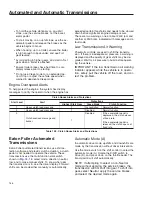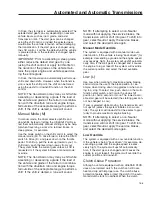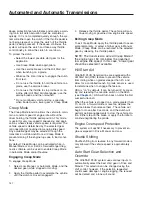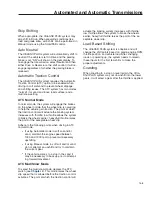
Allow hot brakes to cool before using the spring
parking brakes.
Do not use the spring parking brakes during
freezing temperatures if the service brakes are
wet. To do so could cause them to freeze. If the
brakes are wet, drive the vehicle in low gear and
lightly apply the brakes to heat and dry them.
If the trailer is not equipped with spring parking
brakes, pulling out the parking brake valve applies
the tractor spring parking brakes and the trailer ser-
vice brakes. When the tractor and trailer parking
brakes (or trailer service brakes) are both applied,
the trailer brakes are released by pushing in the
trailer air supply valve, leaving the tractor parking
brakes applied. Air pressure in the primary or sec-
ondary reservoir must be at least 65 psi (447 kPa)
before the tractor spring parking brakes, or the trailer
service or spring parking brakes, can be released.
Automatic Slack Adjusters
Automatic slack adjusters should never be manually
adjusted except during routine maintenance of the
foundation brakes (e.g., replacing shoes), during
slack adjuster installation, or in an emergency situa-
tion.
When the brake pushrod stroke exceeds the legal
brake adjustment limit on a vehicle, there is likely a
mechanical problem with the foundation brake com-
ponents or the adjuster is improperly installed.
Visit a repair facility as soon as possible when
brakes equipped with automatic slack adjusters are
determined to be out of adjustment.
WARNING
Manually adjusting an automatic slack adjuster to
bring the pushrod stroke within legal limits is
likely masking a mechanical problem. Adjustment
is not a repair. Before adjusting an automatic
slack adjuster, troubleshoot the foundation brake
system and inspect it for worn or damaged com-
ponents. Improperly maintaining the vehicle brak-
ing system may lead to brake failure, resulting in
property damage, personal injury, or death.
Meritor WABCO® Antilock
Braking System
The Meritor WABCO Antilock Braking System (ABS)
is an electronic wheel speed monitoring and control
system that works with the standard air brake sys-
tem. ABS passively monitors vehicle wheel speed at
all times, and controls wheel speed during emer-
gency stops.
IMPORTANT: For proper ABS system operation,
do not change tire sizes. The sizes of the tires
installed during production are programmed into
the electronic control unit. Installing different-
sized tires could result in a reduced braking
force, leading to longer stopping distances.
ABS includes signal-generating tone wheels and sen-
sors located in the wheel hubs of each sensed
wheel. The sensors transmit vehicle wheel speed
information to an electronic control unit, located in
the vehicle electronics bay. The control unit’s main
circuit interprets the speed sensor signals and calcu-
lates wheel speed, wheel retardation, and a vehicle
reference speed. If the calculations indicate wheel
lockup, the main circuit signals the appropriate
modulator valve to reduce braking pressure. During
emergency braking, the modulator valve alternately
reduces, increases, or maintains air pressure supply
in the brake chamber to prevent front and rear wheel
lockup.
The electronic control unit (ECU) also has a safety
circuit that constantly monitors the wheel sensors,
traction control valve (if equipped), modulator valves,
and the electrical circuitry.
The Meritor WABCO ABS combines one front-axle
control channel with one rear-axle control channel to
form one control circuit. For example, the sensor and
modulator valve on the left-front axle form a control
circuit with the sensor and modulator valve on the
right-rear axle. If, during vehicle operation, the safety
circuit senses a failure in any part of the ABS, the
driver display presents an ABS warning,the tractor
warning lamp (TRACTOR ABS) illuminates, and the
control circuit where the failure occurred is switched
to normal braking action. See
. The re-
maining control circuit will retain the ABS effect. Even
if the ABS is completely inoperative, normal braking
ability is maintained. An exception would be if a
modulator valve (or combination modulator valve) is
damaged and inoperative. As these components are
an integral part of the air brake system, normal brak-
ing may be impaired or inoperative.
During emergency or reduced-traction stops, fully
depress the brake pedal until the vehicle comes to a
safe stop.
Do not pump the brake pedal
. With the
brake pedal fully depressed, the ABS will control all
wheels to provide steering control and a reduced
braking distance.
Brake Systems
13.4
Summary of Contents for NEW CASCADIA 2016
Page 1: ... NEW CASCADIA Driver s Manual Part Number STI 500 Publication Number STI 500 8 ...
Page 5: ......
Page 11: ......
Page 38: ...f611444 10 31 2016 Fig 3 23 Sample Alert Messages Instruments 3 20 ...
Page 39: ......
Page 93: ......
Page 94: ...8 Cab and Sleeper Features Windows 8 1 Mirrors 8 1 Cab Amenities 8 1 Sleeper Amenities 8 2 ...
Page 99: ......
Page 125: ......
Page 134: ...14 Steering System Power Steering System 14 1 ...
Page 145: ......
Page 146: ...16 Manual Transmissions and Clutch Eaton Fuller Manual Transmissions 16 1 Clutch 16 1 ...
Page 149: ......
Page 150: ...17 Drive Axles Interaxle Lock Tandem Axles 17 1 Driver Controlled Differential Lock DCDL 17 2 ...
Page 164: ...19 Trailer Couplings Holland Trailer Coupling 19 1 ...
Page 177: ......
Page 191: ......
Page 198: ...25 Specifications Fluids and Lubricants 25 1 ...







































